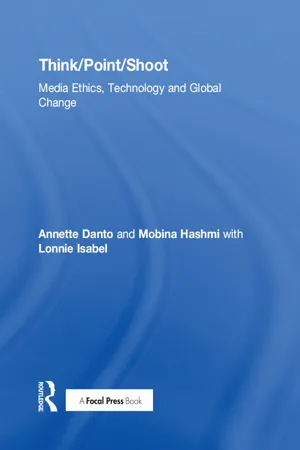![]()
Section One
Think
![]()
Introduction to Section One
Think
Annette Danto and Mobina Hashmi
THERE has never been a more exciting time to enter the world of media. Inventive cameras, apps, and software innovation have made it easier than ever to turn dreams and ideas into realities.
No longer do you have to be a passive spectator. With new media it is now possible to engage and interact with others from all over the world. This is indeed an exciting time thanks to extraordinary technological inventiveness
Tools of production today are affordable and easy to access. Distribution is no longer only available to the privileged few. Today, your media can be viewed across the globe through a growing range of distribution options: Vimeo, Netflix, YouTube, iTunes, Amazon.
Although it has become much easier to create media, deciding what you want to create and what you want to say remains, perhaps, the most challenging part of production. Are you drawn to personal stories, emotional situations, problems and challenges of living? Do you want to become an investigative journalist, examining injustice and serious social problems? Or, would you rather design an environment where people can interact, or perhaps a successful lifestyle blog? Answering these questions may point you in the right direction regarding coming up with a story, finding a target audience, potential funders, and suitable collaborators.
Identifying key sources of inspiration can help you craft a stylistic approach. For example, are you drawn to the humanistic filmmaking styles of Indian filmmaker Satyajit Ray,1 and Iranian filmmaker Abbas Kiarostami?2 Or do you prefer the quirky, action-adventure movies of Joel and Ethan Coen?3
A no less important point to clarify during this early stage is: why do you want to create? If your ultimate goal is to be able to afford a house in Hollywood Hills with a swimming pool, then you need to focus on commercial media creation. For commercially driven media projects it is often important to select a topic that will appeal to a sizeable audience. Selecting media content based on Google Keyword Traffic Estimator, for example, will allow you to gauge the number of people likely to be interested in a particular topic. Alternatively, if your goal is to communicate an idea that you are strongly passionate about to the public at large regardless of monetary gain, then the size of the audience is of secondary importance. Creating media that enables a conversation between members of a specific group is yet another option you may want to think about.
Figure S1.1 Although it has become much easier to create media, deciding what you want to say remains a challenge. Credit: www.Rawpixel.com.
With all these possibilities it is important to be honest with yourself as you clarify your motivation and goals.
The moment you start talking about an idea for a media project, you are in early preproduction. Preproduction is about coming up with a story concept, making decisions, and setting goals. Reactions to things we see, hear, or experience generate ideas or may inspire us to create or communicate. Asking salient questions as part of this process will guide media-makers along a creative path that is both ethical and principled:
- Am I thinking of the public interest? Or, am I focusing only on my individual creative desires or on what will be profitable?
- Am I aware of my cultural standpoint? How does this influence the conceptual frame of the story and is this reflected in the theme and premise?
- Is it my goal to describe what exists or to advocate for a specific position? Do I have an obligation to promote “virtuous”4 behavior in my audience?
- Am I ascribing too much or not enough agency to the audience? Do I give the audience what it wants even at the risk of reinforcing problematic attitudes and behaviors?
The time between having a thought and engaging in media creation and distribution may be the split-second it takes to share a social media post, or it may be the months it takes to create an investigative television news story. This is when you need to take the “detour through theory” described in the introduction and need to ask the questions listed above.
Medium-Specific Preproduction
The preproduction process is not the same for all media. Below, we briefly describe considerations specific to three of the main types of media creation in our current environment.
Filmmaking: Narrative and Documentary
Preproduction is about writing a treatment, based on careful research. This includes watching other media about the topic. It is about identifying potential funding sources, selecting a target audience and evaluating distribution deals that may offer funding up front. Finding possible collaborators and contacting them is another necessary step to initiate during the preproduction period. Overall, this is the time to figure out how to make your story come alive.
If we had to pick one single ethical consideration to keep in mind at this stage, it would be stereotyping. As you are framing your story, be aware of the perspective you are privileging. That is, who is the “us” and the “them” in your story? Have you considered how your narrative and aesthetic choices support or challenge existing norms and biases?
New Media and Social Media
Diverse forms of media function and progress in dissimilar ways through this early stage. Operating at varied speeds, with contrasting approaches to interactivity, diverse media allot inconsistent amounts of time for conscious thought.
With new media, what we are calling “preproduction” can be almost simultaneous with production and distribution. Furthermore, new media and social media creation can take place in isolation, within the privacy of one’s own space. There are fewer gatekeepers. This, along with the time differential, places increased responsibility on the media creator to predict ethical dilemmas intrinsic to the topic or concept being considered. This demands fore- thought along with greater self-reflection and self-regulation even before preproduction. For example, we might consider the degree to which our choice of social media platform contributes to what Andrejevic (2006) calls “lateral surveillance” when we participate in, and implicitly endorse, a culture of surveillance by spying on what our friends, family, colleagues, or partners are doing online.
Journalism
Preproduction is a time of research and development. It is a time to think carefully about sources, words, visuals, and headlines. It is about what best suits the target audience and goals of the story.
Preproduction presents an opportunity for thoughtful construction of messages, images, characterizations, and stories. Accuracy, transparency, and objectivity are three key news values repeated in professional codes of ethics. But, keeping framing theory in mind, we have to ask how an unreflective adherence to objectivity, for example, can simply reinforce a “consensus narrative” by not acknowledging perspectives that lie outside the dominant news frame.5 So, we have to ask how the “facts” are established and how “facts” and “the truth” are connected in news narratives. How, for example, does the commercial imperative to be profitable affect how mainstream news media define objectivity and transparency?
Ethical Considerations in Preproduction
It is important to consider ethics during preproduction. You have to ask if varied media demand alternative strategies when considering ethical process and content.
One important theoretical issue to keep in mind at this stage is whether you are thinking of media as “object” or as “practice.” In other words, are you thinking of your film, web series, news story, or blog post as a project that you create and complete, or are you thinking of your media project as a way of participating in diverse ongoing practices of funding, distribution, viewing, and interaction? Your answer to this question will influence your strategy as you consider, for example, which platform is the best choice for distributing your web series, or the extent to which your television commercial reinforces or challenges existing stereotypes.
For narrative and documentary production, a timeline may continue for months or years, allowing media-makers to ponder potential story issues and ethical dilemmas. With social media there is less time to think about ramifications and consequences. Creating or repurposing a social media post can happen very quickly. When working with media where all stages of production are simultaneous, pre-production in effect can mean the cultivation of an ethical self.
Writing
Writing is not an easy or simple process for most of us. Working on a treatment, a script, or a draft of an article can be stressful. Adding a layer of ethical calculation may slow down the process, increasing doubt and hesitation, and exacerbating cases of writer’s block.
With social media, the writing process happens almost simultaneously with the self-monitoring process. Instantaneous reflection while writing means carefully weighing the pros and cons, what might be right or wrong, who will benefit and who might be harmed; the answers to these dilemmas are never easy or simple.
Writing in the privacy of your own room, you become your own gatekeeper. When translating thoughts into text or ideas into images, remember, once you hit the enter key it is all over. The ethical consequences are beyond your control.
Figure S1.2 Preproduction is the time to cultivate an ethical self. Credit: Jan Faukner.
Consider the impact of your idea on others, apart from your own circle of friends. Feeding into negative stereotypes can happen unwittingly by ideas or story concepts you think are somehow unusual or unfamiliar. This happens often when coming up with ideas about cultures or rituals different from one’s own.
Our aesthetic judgments about what makes for a compelling composition or a moving story are centrally shaped by cultural stereotypes and narrative biases. For example, finding the “human interest” angle in a news story about a workers’ strike can stimulate greater interest in readers, but it can also reduce a complex story about institutional structures to a conflict between individuals. Identifying sensitivities must happen well before hitting the enter key, or pressing the record button on a camera.
Context matters
In preproduction it is necessary to consider who the target audience is, and how they will interpret the form and content of the media being developed. For text-based media, the use of headlines, words, and sources provide reference points for an audience by identifying the perspective of the media source. This directly influences how an audience will interpret the material being presented.
Understanding the realities of our pluralist societies means acknowledging diverse points of view. Thoughtful consideration of where and how your media will be screened is an essential first step in determining the ethics of that media.
When the famous Greek satirist Aristophanes wrote The Frogs in 405 BCE, there was no such thing as “global distribution.” There was no internet. Aristophanes brutally satirized all of Greek society, and it had the kind of impact that the Charlie Hebdo political cartoons have recently had. Caricatures of different classes of society—the manners of the Spartans and other non-Athenians, the conceits of public officers, the avidity of news vendors, priests, poets, not to mention astronomers, sausage-sellers, soldiers, informants, and even flute-girls—left audiences with emotions ranging from tears to hysterics. Nothing and no one was sacred.6
Like many contemporary filmmakers and media creators, Aristophanes used stories as a general mockery of human nature and of the world as he knew it. What seems new today is the potential for global circulation of media. Along with this is the added possibility that whatever is created and posted might get repurposed and reposted with radically different interpretations from the ones originally intended. Keeping in mind how not only your intended audience, but also a plurality of diverse audiences will interpret the form and content is an essential first step in the creation of ethical media today.
Sometimes government media regulators and censorship boards intervene in the distribution process. During preproduction, media creators need to familiarize themselves with government regulation and censorship laws if it applies to a target audience. Choices made during preproduction are essential determinants regarding whether the media created...


